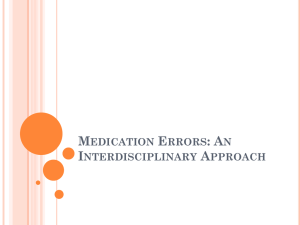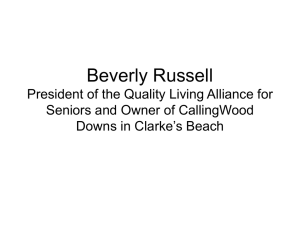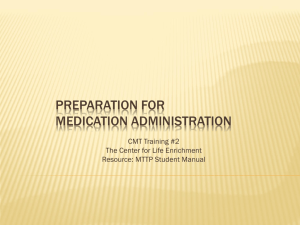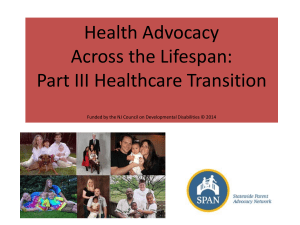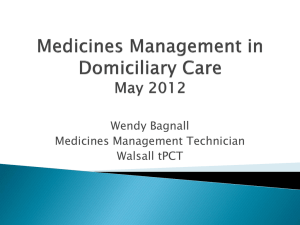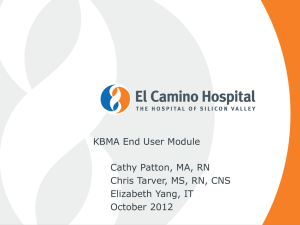Medication Delegation Learning Module
advertisement
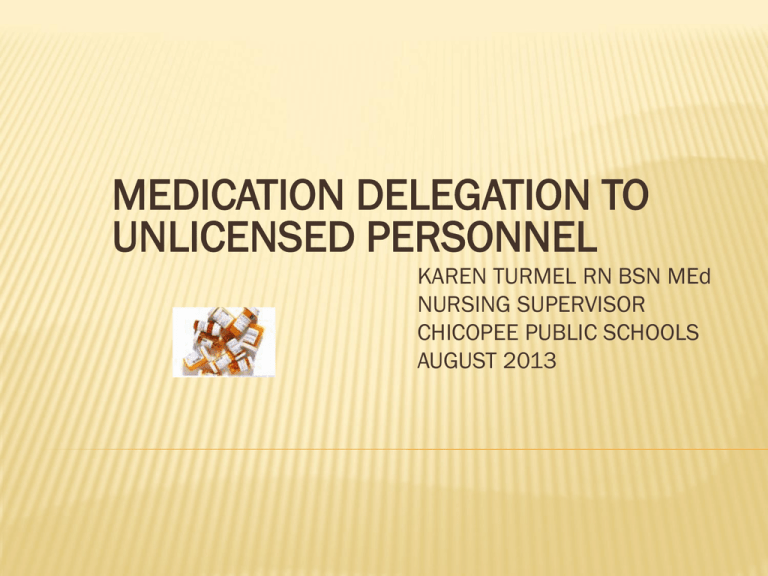
MEDICATION DELEGATION TO UNLICENSED PERSONNEL KAREN TURMEL RN BSN MEd NURSING SUPERVISOR CHICOPEE PUBLIC SCHOOLS AUGUST 2013 TRAINING OBJECTIVES…….. ●Identify accurately the student for whom the medication is ordered. ●Read and interpret accurately the medication administration plan. ●Follow directions on the medication administration plan. ●Read the medication label accurately ●Follow the directions on the medication label ●Demonstrate the safe handling and proper storage of medications ●Demonstrate the ability to administer medication properly ●Describe the proper action to be taken if a medication is not taken/given either by refusal or omission or if an error was made. ●Ability to use resources appropriately: including school nurse, parent/guardian, or emergency service when problems arise. ●Describe appropriate behaviors which assure confidentiality. CONFIDENTIALITY… ALL information about students is confidential! Do NOT discuss or share information about students or medications with other school staff or people outside of school unless directed to do so by the school nurse. Refer all questions or comments about students or medications to the school nurse. ROLE OF UNLICENSED SCHOOL PERSONNEL IN MEDICATION ADMINISTRATION… ●Administers medication(s) or assists or reminds student to take own medication(s) ●Obtains medical information from the medication administration plan developed by the school nurse ●Follows the specific instructions for the administration of each student’s medication ●Administers only those medications where there is a specific order for the specific child ●Reports any unusual reactions ●Reports any problems to the school nurse ●Seeks instruction from the school nurse for any problems or in case of uncertainty. LIMITATIONS OF UNLICENSED SCHOOL PERSONNEL May NOT administer “over the counter” medications under protocols i.e.. Tylenol as it requires an assessment May NOT give medication by injection EXCEPT epinephrine in a life threatening situation where the student has a known allergy and there is a specific order from a licensed prescriber and written consent of parent/guardian HOW MEDICATION WORKS Our body is made up as systems such as digestive, nervous, and respiratory. These systems are made up of organs which are made up of tissues and these tissues are made of cells. Each one of the body’s cells are continuously active with constant chemical reactions. Some of this activity happens with the cell and some by communicating with other cells. This communication between cells is called neurosynaptic transmission. Medication changes the activity of the cells to produce a therapeutic effect. In order to produce a therapeutic effect, there must be enough medication surrounding the cell(s), this is called the level of critical concentration. EFFECTS OF MEDICATION See medication administration plan and school nurse for expected and possible side effects Desired effect: The therapeutic effect means the medication is having the effect intended by the licensed prescriber SIDE EFFECTS Effects caused by the medication that are not the desired effect May occur with the desired effect Many side effects are expected and predictable Some side effects are unexpected and unpredictable, they are called adverse effects For example, severe vomiting and diarrhea when the level of and antipsychotic has risen too high A side effect may be potentially fatal(although rare) Such as drowsiness with phenobarbital when the desired effect is seizure control For example, an allergic reaction to an antibiotic Many side effects are difficult to detect or to determine as caused by the medication NO EFFECT The medication “didn’t work” For example- a student has been taking dilantin for a week and is still having seizures occurring at the same rate and are just as severe as before the medication was started. Any changes that you see (either physical or behavioral) or that are described to you by a student may be caused by a medication Report ALL changes to your school nurse DRUG INTERACTIONS Some students receive more than one medication at a time Some are medications taken on a regular basis and some on a temporary basis Whenever a student takes 2 or more different medications, a drug interaction may occur A drug interaction occurs when one drug alters (decreases, increases, or changes) the effect or action of another 5 RIGHTS OF MEDICATION ADMINISTRATION Right student Right medication Don’t guess, you must identify the student A photo should be attached to the medication plan Compare the medication plan with the pharmacy label Double check making sure they match Check expiration date on medication label Do NOT give if beyond expiration date Notify school nurse Right dosage Compare the medication administration plan with the pharmacy label Double check, making sure they match Carefully count the correct dose and compare again with medication plan Right time Right route Give the medication at the time(s) stated in the medication administration plan Medication prescribed to be given in: Oral route Drops Ointment Injectable Inhalants Tablets, capsules, liquids that are swallowed Such as epi pens for emergency medication only Asthma inhalers STEPS IN MEDICATION ADMINISTRATION Identify student Read medication administration plan Wash hands Select and read label of medication Prepare medication and read label again Read label again and then administer medication If any questions notify School Nurse DO’S AND DON’TS: OTHER SAFEGUARDS TO FOLLOW Don’t: Give medication from a container which has a label that can’t be read Give medication from another student’s container Leave medication unattended Try to hide a medication error Increase or decrease or change in any way the dose of medication without specific instructions from the school nurse Do: give your full attention to the task Remain with the student until medication has been taken making sure student swallowed medication Prepare the medication for only one student at a time ASSISTING STUDENT WITH SELFADMINISTRATION Identify the student Select correct medication Read medication administration plan Read label Observe student prepare and take medication as per medication plan Thank you for taking the time to complete this training. Now there is a written test to be taken and a competency skill checklist that needs to be completed with your school nurse This is a yearly training for all teachers administering medications to students on field trips.
